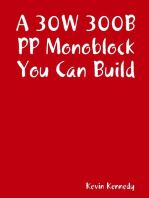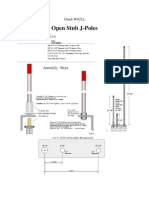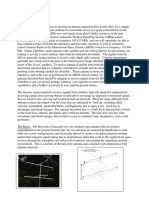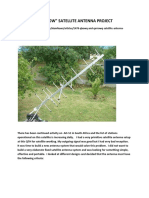Antennas - 2M Moxon Antenna
Antennas - 2M Moxon Antenna
Uploaded by
Iacob LaurentiuCopyright:
Available Formats
Antennas - 2M Moxon Antenna
Antennas - 2M Moxon Antenna
Uploaded by
Iacob LaurentiuCopyright
Available Formats
Share this document
Did you find this document useful?
Is this content inappropriate?
Copyright:
Available Formats
Antennas - 2M Moxon Antenna
Antennas - 2M Moxon Antenna
Uploaded by
Iacob LaurentiuCopyright:
Available Formats
Making an Indoor FM Moxon Antenna
Whether you are an FM DXer or just want to listen to your favorite station with the best reception possible, a Moxon antenna is often an excellent choice. A Moxon uses a driven element and a reflector, and is essentially a folded 2element Yagi antenna. This article describes the construction of an indoor Moxon antenna for those like me who are unable to mount a good FM antenna outdoors. What makes the Moxon a good choice is that it has 5-6 dB gain over a simple dipole antenna, plus it is much more directional than the dipole's figure-8 pattern. At right is a typical theoretical pattern generated by F6IRF which shows a cartioid pattern similar to that obtained when phasing two antennas together. As a result, the gain and directionality often make a substantial difference when compared to the typical wire dipole antennas that come with many receivers. The antenna is basically a horizontal rectangular loop of wire with three gaps, as shown in the diagram below. The dimensions for the antenna loop can be determined using Moxgen, a small freeware program which can be downloaded at http://www.ac6la.com/moxgen.html. For convenience, here is the output screen after inputting 98 MHz (the center of the FM broadcast band) as the center frequency using 18 gauge wire:
For this loop, using the numbers above, the driven element is two lengths of wire, each (43.69/2 + 6.40 =) 28.25 inches, while the reflector is a single piece of wire that is (43.69 + 8.23 + 8.23 =) 60.15 inches. I used 18 gauge stranded speaker, which has a soft plastic jacket which doesn't kink. I connected the three lengths of wire into a loop using plastic zip ties as insulated stand-offs (see picture below). For each of the three wire elements, I cut each about an inch longer than the final length figures above to allow for a loop at each end for connection purposes. I stripped about an inch of insulation off at the end of each wire and formed a small loop, which I soldered into a sturdy loop into which I could insert the zip ties (see picture, below). You could also use some sort of cramp-on spade-type connectors from Radio Shack. Just make sure that the final length (wire plus diameter of the loops) is correct (i.e., 28.25 or 60.15 inches, above).
After connecting everything with zip ties, I had a wire loop that looked exactly like the Moxgen output screen above. While the gap between the driven and reflector elements is specified (i.e., dimension C in the Moxgen output screen above), I made the gap between the two driven elements as small as possible (about 1/4) by cinching the zip tie up as far as it would go.
Detail of soldered loops and 1.4 zip tie connection between driven and reflector elements
Making the Loop Frame and Support Structure
This design uses three 10-foot lengths of 3/4 PVC, plus 8 elbows and 6 tees. The inside dimensions of the antenna frame are 18x48 inches, so the PVC pipe sections will be about 18 and 48 inches long as well, depending on how they fit into the elbow and tee connectors. I didn't use any adhesive on the joints, and so far it has held together just fine. The loop frame is big enough to hold an antenna loop cut for 92 MHz, which focuses on the lower part of the band, although this present antenna loop cut for 98 MHz covers the whole band quite well. For optimum performance, the antenna should be at least half a wavelength (~5 feet for broadcast FM frequencies) off the floor. Initially I had it only a couple feet off the floor, and raising it to 5 feet really made a real difference. As such, the frame is suspended 5 feet off the ground, and the two uprights consist of a 10-foot PVC pipe cut in half. The base is 14x14 inches, measured on the outside, and seems to be stable enough for indoor applications, although it could easily be made larger. There is a 90-degree elbow at the four corners and two tee connectors for the uprights.
Attaching the Loop Frame to the Uprights
While the previous picture shows the loop frame at an angle, in use the Moxon antenna is primarily in the horizontal position. However, I use this indoors, so multipath effects, house wiring, and all other interference causers mean that I often need to tilt the Moxon somewhat to gets the best result, whether to maximize signal or to eliminate interfering stations. To allow the loop frame to tilt, I sawed a groove into two tee connectors, and bored out the insides, so that they would accept a cross-bar and act as a pivot. The tees don't have to hold the cross arm particularly tight, since the antenna is essentially balanced at the midpoint, so the antenna stays where you put it. Below are close-up pictures of the pivot system and the bored-out tee connector.
Pivot system and alligator clip connection
Close-up of pivot tee connector assembly
Snap-on tees are also available, which I recently purchased here at FlexPVC.com. These have a little more relaxed grip than the ones I sawed and bored, so if you go that route, just put a little masking tape inside the snap-on tee to make it hold tighter if need be. Again, since the antenna is balanced, it doesn't need to hold that tightly. Another benefit of using this pivoting design is that, when not in use, the antenna element may be turned vertical for easier storage of the entire assembly. I chose not to use any PVC adhesive on mine, but instead rely on the inherent tightness of the joints. I haven't had any problems so far, and it allows me to disconnect the uprights in order to store it in an even more compact manner.
Attaching the Antenna Loop
To attach the wire antenna loop to the frame, there are (non-conductive) brass screws at the four corners on top, with rubber bands which hold the antenna loop straight (see picture below). I marked the wire loop at the four places where corners should be with a Sharpie marker, thereby making sure that the rubber bands were holding the exact corner. The rubber band arrangement keeps the loop taught, lifts the loop above the plane of the PVC (not that PVC is a particularly absorptive material) and the loop naturally stays in one level plane.
To connect the antenna to your receiver, as shown in the photograph on the previous page, the two ends of the driven element are connected directly to the two conductors of a standard 75-ohm cable. No balun is needed, as the Moxon is an intrinsically 50-75 ohm antenna. While I am currently using alligator clips to make this connection (see picture on previous page), I intend to install a permanent F-connector at some point. Because of space constraints, I have the antenna in one room and the receiver in another, but the 25 feet of 75-ohm feed line does not induce appreciable loss, and the signal at the receiver is not noticeably attenuated. To use the Moxon antenna, just point the broadside of the driven element (i.e., the alligator clip side) in the direction you want, and that will be your peak, while relative nulls to the side and back will help reduce interference. Pivoting the loop frame one way or the other will typically produce a cleaner signal or reduce the strength of an interfering station. As promised by the theoretical calculations, the gain is significantly better than even a carefully cut dipole antenna, and the directional nature of the antenna allows me to often pick up more than one station on a given frequency. For more information on these antennas, which are suitable for many different frequencies, visit www.moxonantennaproject.com Kevin S., Bainbridge Island, WA
You might also like
- Construction of A Quadrifilar Helix AntennaDocument5 pagesConstruction of A Quadrifilar Helix AntennaSmai HondoNo ratings yet
- Handmade Slim Jim Antenna's by N9TAXDocument8 pagesHandmade Slim Jim Antenna's by N9TAXshubhamformeNo ratings yet
- Antena Movil HFDocument10 pagesAntena Movil HF10sd156100% (1)
- Inexpensive 17-Meter VerticalDocument10 pagesInexpensive 17-Meter VerticalSwlVUNo ratings yet
- Antenna HandoutDocument8 pagesAntenna HandoutPhil BoxxNo ratings yet
- 40 Meters VerticalDocument10 pages40 Meters Verticalعرفان عرفانNo ratings yet
- Fractal Magic DIY HDTV Antenna PDFDocument56 pagesFractal Magic DIY HDTV Antenna PDFDarin ArmsteadNo ratings yet
- How Make Wifi Feed HornDocument5 pagesHow Make Wifi Feed HornRajesh Punia100% (2)
- Fractal Magic DIY HDTV AntennaDocument33 pagesFractal Magic DIY HDTV AntennaLeonel RodriguezNo ratings yet
- Design and Construction of A Quadrifilar Helix Antenna For Receiving NOAA Satellites 1Document6 pagesDesign and Construction of A Quadrifilar Helix Antenna For Receiving NOAA Satellites 1Luis MartinezNo ratings yet
- Antenna VLFDocument10 pagesAntenna VLFAnonymous vRX0OvwH100% (1)
- Fractal Magic DIY HDTV AntennaDocument56 pagesFractal Magic DIY HDTV Antennadetroit_me2553100% (3)
- 2 Meter Backpack Quad AntennaDocument27 pages2 Meter Backpack Quad Antennaadel agustiNo ratings yet
- GPS Helical Antenna DesignDocument6 pagesGPS Helical Antenna DesignGuadalajara Jalisco100% (1)
- A High Performance Airband Antenna For Your Ultralight / Lightsport AircraftDocument9 pagesA High Performance Airband Antenna For Your Ultralight / Lightsport AircraftDecebal ScorilloNo ratings yet
- 6el 21MHzOWADocument6 pages6el 21MHzOWApu2kgpNo ratings yet
- ISS Minimalist AntennaDocument7 pagesISS Minimalist AntennaBoed SNo ratings yet
- Build A 9dB, 70cm Collinear AntennaDocument3 pagesBuild A 9dB, 70cm Collinear Antennadr3x100% (1)
- Loop Skywire AntennaDocument7 pagesLoop Skywire Antennaandres_scribdNo ratings yet
- 3 El HexDocument9 pages3 El HexSilva JoséNo ratings yet
- CollantDocument2 pagesCollantpogee752No ratings yet
- DIY TV AntennasDocument29 pagesDIY TV Antennasvadmanh83% (6)
- 2040 Di Pole 20200623Document6 pages2040 Di Pole 20200623cat6313No ratings yet
- A Pedestrian-Portable 2m/70cm Walking Stick Antenna For The "Ham Gentleman"Document9 pagesA Pedestrian-Portable 2m/70cm Walking Stick Antenna For The "Ham Gentleman"bbas6825No ratings yet
- Varied 2 Meter Homebrew Antennas-ERC TrainingDocument15 pagesVaried 2 Meter Homebrew Antennas-ERC TrainingIndika Withanage100% (1)
- Arrow Antenna 1Document20 pagesArrow Antenna 1ratmonNo ratings yet
- Antenna InstructionsDocument2 pagesAntenna Instructions2wheelerNo ratings yet
- 2-Meter Vertical Dipole ArrayDocument15 pages2-Meter Vertical Dipole ArrayJacky SinurayaNo ratings yet
- ARES 2M Moxon AntennaDocument14 pagesARES 2M Moxon AntennaKenburNo ratings yet
- End Fed 40meter Half Wave AntennaDocument4 pagesEnd Fed 40meter Half Wave AntennaDefaultAnomoly100% (1)
- How To Make A Dipole AntennaDocument3 pagesHow To Make A Dipole AntennarzmNo ratings yet
- 2-Meter Vertical Dipole ArrayDocument15 pages2-Meter Vertical Dipole ArrayRádioWeb SapucaiaNo ratings yet
- 2 Element Wire YagiDocument3 pages2 Element Wire YagiJon StromslandNo ratings yet
- 8 and 24 MHZ Limited SpaceDocument7 pages8 and 24 MHZ Limited Spaceadel agustiNo ratings yet
- End Fed 6 - 40 Meter Multiband HF AntennaDocument6 pagesEnd Fed 6 - 40 Meter Multiband HF AntennalimazulusNo ratings yet
- 2 Meter Sling Shot AntennaDocument7 pages2 Meter Sling Shot AntennaNiko Diamesis100% (1)
- 70cm Collinear AntennaDocument3 pages70cm Collinear AntennaRds Comunicaciones EirlNo ratings yet
- Eggbeater 2Document5 pagesEggbeater 2Richard LinderNo ratings yet
- Co Linear Antenna DesignDocument2 pagesCo Linear Antenna DesignAhmed JafarNo ratings yet
- Designing and Constructing A Magnetic Loop Antenna: Presentation To The Richmond Amateur Radio ClubDocument52 pagesDesigning and Constructing A Magnetic Loop Antenna: Presentation To The Richmond Amateur Radio ClubDarko EpliNo ratings yet
- 40 MTR Vertical HF Radio Antenna Aerial - Ultra Easy SystemDocument8 pages40 MTR Vertical HF Radio Antenna Aerial - Ultra Easy Systemg0ier100% (1)
- Router Parabolic Dish TemplateDocument6 pagesRouter Parabolic Dish TemplateRichard BaylissNo ratings yet
- Antena Cubica Circular VHFDocument9 pagesAntena Cubica Circular VHFAmanda Hardy100% (1)
- BALCONY ANTENNA by SM0VPODocument4 pagesBALCONY ANTENNA by SM0VPOLeopoldo AlvarezNo ratings yet
- The BNC Portable HF Loading Coil Rev 12 22Document8 pagesThe BNC Portable HF Loading Coil Rev 12 22Octavian S.No ratings yet
- Dual Core Balun Construction ProjectDocument7 pagesDual Core Balun Construction ProjectCarlos Merello100% (1)
- Cobwebb 2Document7 pagesCobwebb 2yo8rzeNo ratings yet
- Super Rod Squid Pole AntennaDocument7 pagesSuper Rod Squid Pole AntennadandjNo ratings yet
- TH 3jrs ManualDocument11 pagesTH 3jrs ManualOscar NavaNo ratings yet
- 2 Good Shortwave Antenna IdeasDocument5 pages2 Good Shortwave Antenna IdeasmemeticdriftNo ratings yet
- Pacific Antenna 20 and 40M Lightweight Dipole Kit: Diagram Showing Configuration and Approximate LengthsDocument6 pagesPacific Antenna 20 and 40M Lightweight Dipole Kit: Diagram Showing Configuration and Approximate LengthsedosviracNo ratings yet
- Build A Dou Le Baz Ka Ante A: It's Called A "Double Bazooka"Document9 pagesBuild A Dou Le Baz Ka Ante A: It's Called A "Double Bazooka"etanNo ratings yet
- How to Make Electrical Machines: Containing Full Directions for Making Electrical Machines, Induction Coils, Dynamos, and Many Novel Toys to Be Worked by ElectricityFrom EverandHow to Make Electrical Machines: Containing Full Directions for Making Electrical Machines, Induction Coils, Dynamos, and Many Novel Toys to Be Worked by ElectricityNo ratings yet
- Delco Radio Owner's Manual Model 633; Delcotron Generator InstallationFrom EverandDelco Radio Owner's Manual Model 633; Delcotron Generator InstallationNo ratings yet
- Delco Manuals: Radio Model 633, Delcotron Generator Delco Radio Owner's Manual Model 633, Delcotron Generator InstallationFrom EverandDelco Manuals: Radio Model 633, Delcotron Generator Delco Radio Owner's Manual Model 633, Delcotron Generator InstallationNo ratings yet
- Macramé for Beginners and Beyond: 24 Easy Macramé Projects for Home and GardenFrom EverandMacramé for Beginners and Beyond: 24 Easy Macramé Projects for Home and GardenRating: 4.5 out of 5 stars4.5/5 (8)



























































